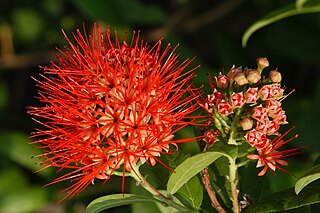
The Combretaceae, often called the white mangrove family, are a family of flowering plants in the order Myrtales. The family includes about 530 species of trees, shrubs, and lianas in ca 10 genera. The family includes the leadwood tree, Combretum imberbe. Three genera, Conocarpus, Laguncularia, and Lumnitzera, grow in mangrove habitats (mangals). The Combretaceae are widespread in the subtropics and tropics. Some members of this family produce useful construction timber, such as idigbo from Terminalia ivorensis. The commonly cultivated Quisqualis indica is now placed in the genus Combretum. Many plants in the former Quisqualis genus contain the excitotoxin quisqualic acid, a potent AMPA agonist.
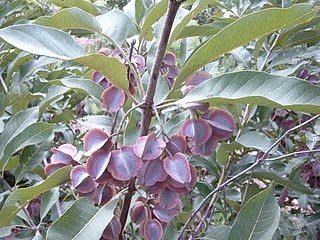
Combretum, the bushwillows or combretums, make up the type genus of the family Combretaceae. The genus comprises about 272 species of trees and shrubs, most of which are native to tropical and southern Africa, about 5 to Madagascar, but there are others that are native to tropical Asia, New Guinea and the Bismarck Archipelago, Australia, and tropical America. Though somewhat reminiscent of willows (Salix) in their habitus, they are not particularly close relatives of these.

Punicalagin (Pyuni-cala-jen) is an ellagitannin, a type of phenolic compound. It is found as alpha and beta isomers in pomegranates, Terminalia catappa, Terminalia myriocarpa, and in Combretum molle, the velvet bushwillow, a plant species found in South Africa. These three genera are all Myrtales and the last two are both Combretaceae.
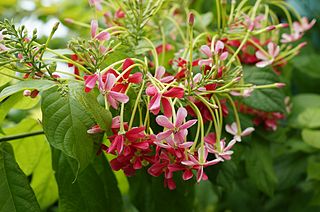
Combretum indicum, commonly known as the Rangoon creeper or Burma creeper, is a vine with red flower clusters which is native to tropical Asia and grows in thickets, primary and secondary forest, and along river banks in the Indian subcontinent, Malaysia and the Philippines. It has since been cultivated and naturalized in tropical areas such as Burma, Vietnam, and Thailand.

The wildlife of the Gambia is dictated by several habitat zones over the Gambia's land area of about 10,000 km2. It is bound in the south by the savanna and on the north by the Sudanian woodlands. The habitats host abundant indigenous plants and animals, in addition to migrant species and newly planted species. They vary widely and consist of the marine system, coastal zone, estuary with mangrove vegetation coupled with Banto Faros, river banks with brackish and fresh water zones, swamps covered with forests and many wetlands.
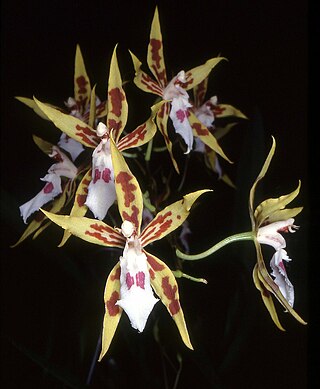
Oncidium constrictum, synonym Odontoglossum constrictum, is a species of orchid found from Colombia to northern Venezuela.

Sphinctospermum is a genus of flowering plants in the legume family, Fabaceae. It belongs to the subfamily Faboideae. It is a monotypic genus, containing the single species Sphinctospermum constrictum. It is native to North America, where it occurs in western and central Mexico and in Arizona in the southwestern United States. The plant is known by the common name hourglass peaseed.

Combretol is an O-methylated flavonol, a type of flavonoid. It is the 3,7,3',4',5'-O-methylation of myricetin and can be extracted from Combretum quadrangulare and from Rhodomyrtus tomentosa.

Combretum glutinosum is a shrub species of the genus Combretum, found in the Sahel belt in parts of Senegal, Burkina Faso, Ghana, Mali, the Gambia, Niger, Nigeria and Cameroon, across to parts of Sudan. It is known as dooki in Pulaar, Kantakara in Hausa, rat in Wolof and jambakatan kè in Maninka. Its synonyms are Combretum cordofanum Engl. & Diels, C. passargei Engl. & Diels, C. leonense Engl. & Diels.

Punicalin is an ellagitannin. It can be found in Punica granatum (pomegranate) or in the leaves of Terminalia catappa, a plant used to treat dermatitis and hepatitis. It is also reported in Combretum glutinosum, all three species being Myrtales, the two last being Combretaceae.

Combretum molle, the velvet bushwillow, is a medium to large tree species in the genus Combretum found in western, eastern and southern Africa.
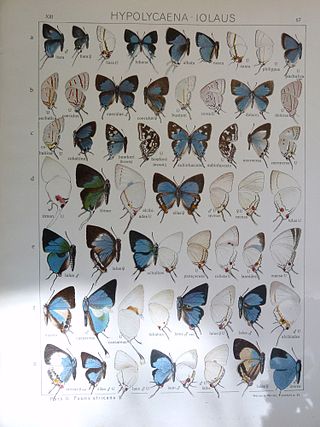
Hypolycaena pachalica, the eastern hairstreak, is a butterfly in the family Lycaenidae. It was described by Arthur Gardiner Butler in 1888. It is found in Uganda, eastern and northern Kenya, the Democratic Republic of the Congo, Tanzania, Malawi, Zambia, south-western Saudi Arabia and Yemen. The habitat consists of savanna and open forests.

Combretum paniculatum, the burning bush or forest flame-creeper, is a plant species in the genus Combretum found in Africa. The fruit is a samara, i.e. a winged seed.
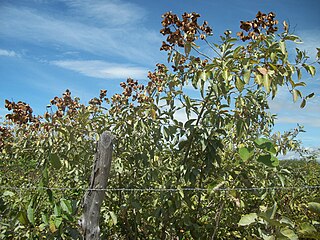
Combretum leprosum, the mofumbo in Portuguese and the asucaró in eastern Bolivian Spanish, is a plant species in the genus Combretum found throughout the Amazon Basin.

Combretum hereroense, commonly known as the russet bushwillow and the mouse-eared combretum, is a deciduous shrub or small tree that is found from eastern Africa to northern South Africa. Over its extensive range it is variable with respect to leaf shape, fruit size and indumentum.

Astrobrachion constrictum is a basket star in the family Euryalidae. It is mostly found at depths of between 50 and 180 m, but around the coast of New Zealand it occurs in shallow waters, in association with the black coral Antipathella fiordensis.
Bembidion constrictum is a species of ground beetle in the family Carabidae. It is found along the Atlantic and Gulf of Mexican coasts of North America, from southeastern Texas (USA) to the Maritime provinces (Canada). Inland records likely refer to other species.
Combretum celastroides is a species of flowering plant in the bushwillow genus Combretum, family Combretaceae. It is found in Zambia, Zimbabwe, Botswana, and Namibia, and is also known in English as Jesse-bush bushwillow, Trailing bushwillow, or Zambezi jessebush, and in local languages as Mugalusaka and Umlalanyathi.
















